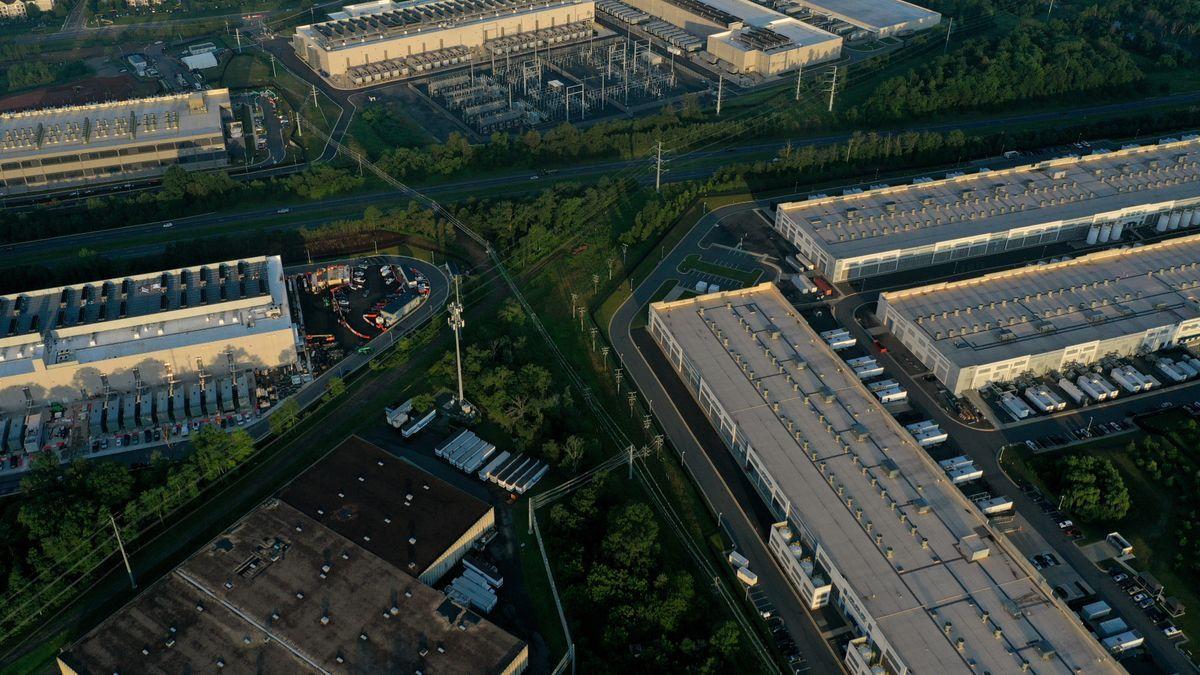AI Data Centers Spark Surge in Electricity Costs for Consumers
4 Sources
4 Sources
[1]
The AI Data Center Boom Is Driving Up Electricity Costs, Research Shows
The price of electricity, juiced by demand from power-hungry data centers, is being passed on to residential customers. Electricity bills are going up around the US, but they're rising even more sharply in areas located near data centers, according to an investigation into power costs by Bloomberg. The price of wholesale electricity has risen as much as 267% over the last five years in data center hot spots, according to the report, which also found that those costs are being passed onto home customers. Data centers, which support functions including cloud storage, video streaming and AI training for companies of all sizes, use a tremendous amount of electrical and water resources. It's estimated that their electrical usage will double by 2035 as power plants expand to support our data needs. Don't miss any of our unbiased tech content and lab-based reviews. Add CNET as a preferred Google source. AI, in particular, including demands as simple and numerous as ChatGPT queries, relies on data centers. Companies with big bets on AI, including Microsoft, Meta, Google and Amazon, have been investing in data centers and power sources, including nuclear power, to meet their energy demands. ChatGPT maker OpenAI, which is currently building a massive data center in Abilene, Texas, last week announced plans for five more supersized data centers across the US. The Bloomberg investigation analyzed data from 25,000 nodes used by seven regional transmission authorities to estimate how much the price of wholesale power has changed since 2000. The report found that the spike in prices is affecting the cost of electricity for households and businesses, including fees to maintain and expand electrical networks. "That can affect customers who aren't in close proximity to a data center, since their energy relies on the same grid," the story says.
[2]
Data center boom sends some wholesale electricity prices soaring up to 267% in five years, says report -- as global rollout of AI factories continues apace
Compounded with rising fuel and food costs, many households near these hotbeds of investment are struggling to stay afloat. Residents living near some of the recently constructed data centers designed to power the AI boom (or bubble) are reporting skyrocketing costs for electricity, as the data centers' unprecedented demands on local power infrastructure place additional strain on regional power grids. In some cases, Bloomberg reports prices rising by over 2.5 times in just a few years, making it hard for some residents to afford their daily bills. Inflation remains a concern for some in the U.S -- trade tariff uncertainty and global trade wars have meant that much of this has seen incredible instability and volatility in various markets. One area that has been doing very well, though, is technology, where the major firms have seen enormous stock price rises as part of the AI boom amidst enormous circular deals. But even that may be harming consumers, it turns out, thanks to huge increases in electricity prices. In its analysis of Grid Status' energy data analytics, Bloomberg found that for areas located near new data centers built to run and train AI, wholesale electricity prices had risen by up to 267%. Although that cost doesn't necessarily have to be passed on to the consumer, some of its cited examples clearly show that happening. It cites the case of Kevin Stanley, a 57-year-old man who survives on disability payments, who has seen his electricity costs rise by 80% in the past three years. Mary Ruffine from Arlington, Virginia, saw her bills rise by over 25% in a single jump. Other unnamed sources claim their budgets are being stretched to the limit by existing electricity price rises. Anything more and they're likely to hit a breaking point. All of them live within a few tens of miles from new data centers powering what many of these companies call the future. The concern is that AI is really just getting started. Most of the huge data center projects announced this year haven't even broken ground yet. When they do, their electricity costs are going to be enormous. Some reports suggest that almost 10% of the entire US electricity demand will come from data centers by 2035. Recently, OpenAI teased a 10 billion GPU future where everyone on Earth might have their own personal GPU for AI. One solution to that is the building of on-site power generation. That's how xAI's Colossus data center got up and running so quickly: by installing tens of gas turbines. Elon Musk is also transporting an entire power plant to his AI projects in order to maintain steady power. That could help stop local electricity prices from rising, and if they don't use all the power from these new facilities, maybe it could even lower costs. Even in that ideal scenario, though, that then raises questions of the environmental impact. Power demands for these facilities aren't going to go down any time soon, and the tech companies behind them only seem too keen to accelerate their development, despite ongoing concerns over funding.
[3]
AI Data Centers Are Sending Power Bills Soaring
Data centers are proliferating in Virginia and a blind man in Baltimore is suddenly contending with sharply higher power bills. The Maryland city is well over an hour's drive from the northern Virginia region known as Data Center Alley. But Kevin Stanley, a 57-year-old who survives on disability payments, says his energy bills are about 80% higher than they were about three years ago. "They're going up and up," he said. "You wonder, 'What is your breaking point?'" It's an increasingly dramatic ripple effect of the AI boom as energy-hungry data centers send power costs to records in much of the US, pulling everyday households into paying for the digital economy. The power needs of the massive complexes are rapidly driving up electricity bills -- piling onto the rising prices for food, housing and other essentials already straining consumers. That's starting to have economic and political reverberations across the country as utilities and local officials wrestle over how to divvy up the costs. Yet those same facilities are a linchpin of US leadership in the global AI race. A Bloomberg News analysis of wholesale electricity prices for tens of thousands of locations across the country reveals the effects of the AI boom on the power market with unprecedented granularity. Electricity now costs as much as 267% more for a single month than it did five years ago in areas located near significant data center activity. About two-thirds of the power consumed in the US runs off of a state or regional grid, where the system operator manages the trading of energy. These wholesale commodity costs are passed on to households and businesses on their utility bills, which then include other charges to maintain and expand the network. That can affect even customers who aren't in close proximity to a data center, since their energy relies on the same grid. Every day, wholesale electricity prices are measured in real time by Locational Marginal Pricing points on the power grid, called nodes. LMPs are primarily made up of the cost to produce the energy and congestion. Analyzing data from 25,000 nodes used by seven regional transmission authorities, Bloomberg News estimated how much wholesale prices in the lower 48 states have changed since 2020. Tech companies, now among the biggest and most powerful forces in the world, have staked their future on AI. Data centers -- some with a footprint large enough to cover much of Manhattan -- are chock full of racks of servers delivering computer power and storage needed to train and run models. Their power needs are only set to accelerate. In recent weeks alone, Nvidia Corp. said it will invest as much as $100 billion in OpenAI to support new data centers, while Microsoft Corp. struck a multiyear deal worth almost $20 billion to get cloud computing power from Amsterdam-based Nebius Group NV using a New Jersey data center. OpenAI and Oracle Corp. forged a partnership to build 4.5 gigawatts' worth of data center capacity, enough energy to power millions of American homes. "The reliability crisis is here now; it's not off in the distance somewhere," said Mark Christie, a former chairman of the Federal Energy Regulatory Commission who also served as a long-time Virginia regulator. He said that load forecasts -- the expected demand for power on electricity grids -- are a key factor pushing up costs, driven by the data center interconnection requests. The affordability problem extends beyond US borders. Power auction prices in Japan hit all-time highs amid government expectations of an AI boom, while Malaysia is lifting electricity rates for data centers as new facilities tighten supply. In the UK, a report from Aurora Energy Research found that higher demand from data centers could push power prices up 9% by 2040. Globally, data centers are expected to consume more than 4% of electricity by 2035, according to BloombergNEF. Put another way: If the facilities were a country they'd rank fourth in electricity use, behind only China, the US and India. In the US, power demand from data centers is set to double by 2035, to almost 9% of all demand, according to BNEF. Some predict it will be the biggest surge in US energy demand since air conditioning caught on in the 1960s. That comes as the grid is already struggling to update aging infrastructure and adapt to climate change. "Without mitigation, the data centers sucking up all the load is going to make things really expensive for the rest of Americans," said David Crane, chief executive officer of Generate Capital and a former energy official in the Biden administration. All that demand risks brownout situations in some US power markets within the next year or two, he said. President Donald Trump, who won election in part because of Americans' dissatisfaction with higher consumer costs, said on the campaign trail that he would cut electricity prices in half within 18 months of taking office. Yet prices have only risen since his inauguration. His energy chief said this month that soaring power bills are now his biggest concern. The president has championed America's AI dominance while also stripping support for new sources of energy like solar and wind farms with his One Big Beautiful Bill Act, which some experts say will increase average household energy bills. BNEF forecasts that annual deployment of new solar, wind and energy storage facilities in 2035 will be 23% lower than it would have been without the bill. Trump has instead focused on unlocking power through expanding the use of coal, natural gas and nuclear energy. In a statement, White House spokeswoman Taylor Rogers blamed the Biden administration's climate agenda and "destructive" policies for driving up energy prices. "President Trump's actions to unleash American energy are the only reason our country has not experienced blackouts and grid failures that would have occurred" under the prior policies, she said. PJM Interconnection, the operator of the largest US electric grid, has faced significant strain from the AI boom. The rapid development of data centers relying on the system raised costs for consumers from Illinois to Washington, DC, by more than $9.3 billion for the 12 months starting in June, according to the grid's independent market monitor. Costs will go up even more next year. Demand tied to the cryptocurrency boom, new factories and the electrification of the economy, including vehicles and home heating, are also pushing up power bills. The cost of natural gas, the No. 1 power-plant fuel in the US, is increasing thanks to all of this demand. And in the zone that includes Baltimore, the planned retirement of coal plants has increased the price of power by decreasing projected supply. Baltimore residents saw their average bill jump by more than $17 a month after a power auction held by PJM reached a record high, according to Exelon Corp.'s Baltimore Gas & Electric utility. This year's auction set another record, which will boost the average power bill in Baltimore again by up to $4 starting in mid-2026. Read more of Bloomberg's coverage on how data centers are impacting communities globally: AI Is Already Wreaking Havoc on Global Power Systems AI Needs So Much Power, It's Making Yours Worse AI Is Draining Water From Areas That Need It Most There has been a "massive outcry about high energy bills" in the area, said David Lapp of the Maryland Office of People's Counsel, an independent state agency that advocates for residential utility customers. His office fields about 50 calls a week and recently hired a new staffer to help manage the requests for help. A comic strip taped to his office door makes a dark joke about AI causing the power grid to collapse. Nicole Pastore, who has lived in her large stone home near Baltimore's Johns Hopkins University campus for 18 years, said her utility bills over the past year jumped by 50%. "You look at that and think, 'Oh my god,'" she said. She has now become the kind of mom who walks around her home turning off lights and unplugging her daughter's cellphone chargers. And because Pastore is a judge who rules on rental disputes in Baltimore City District Court, she regularly sees poor people struggling with their own power bills. "It's utilities versus rent," she said. "They want to stay in their home, but they also want to keep their lights on." Stanley's neighborhood is a mix of well-tended houses like his and those that are condemned or abandoned, with broken windows and holes in the walls. He used to work as a hotel manager but glaucoma took his vision almost 20 years ago, leaving him with few employment options. "They can say this is going to help with AI, but how is that going to help me?" he said from his front steps. "How's that going to help me pay my bill?" The analysis of 25,000 LMP nodes examined the relationship between the change in wholesale electricity prices and the nodes' distance from data centers. The analysis reveals that LMP nodes with increases are more likely to be concentrated near data centers. The boom highlights a stark trade-off: Data centers devour electricity and water, but also are required for the tech-driven conveniences of the modern era, whether it's using ChatGPT for queries, getting matched with an Uber driver or seeing streaming recommendations on Netflix. Even some activists who protest widespread development of the facilities acknowledge that their digital lives rely on them. In 2024, the three biggest US cloud providers -- Amazon.com Inc., Microsoft and Alphabet Inc.'s Google -- spent more than $200 billion on capital expenditures, most of it to construct data centers. To ease the pressure, tech companies are working on ways to speed additional power capacity to the grid while developing better techniques for cooling data centers and chips that use less energy. Hyperscalers are collectively bringing back old reactors, spurring upgrades at existing plants and investing in next-generation nuclear power. In some US regions it's clear that data centers are a major influence on the surge in energy costs. They are the largest source of new power consumption in Texas by far. Dominion Energy Inc. -- which serves northern Virginia's Data Center Alley -- forecast that its peak demand would rise by more than 75% by 2039 with data centers. It would be just 10% without. Against that backdrop, power costs have become a key issue in this year's gubernatorial elections in Virginia and New Jersey. Utilities across the US say they are trying to ensure tech firms pay a fair share for the electricity and infrastructure upgrades their data centers require. Some power companies have moved to require tech firms to put up more collateral or pay for specific amounts of electricity, even if they end up using less. "We believe data centers should pay for the full cost of their power," Dominion spokesperson Aaron Ruby said in an email. "That's how we design our rates, and it's the standard our regulator uses in reviewing them." Ruby added that infrastructure costs are allocated based on how much it costs to serve each group of customers, with data centers paying an increasingly large percentage of transmission costs. Calvin Butler, the CEO of Exelon, said the company is pushing for long-term solutions that are fair and bring peace of mind to customers. "While we can't control every factor driving up prices, we refuse to stand by," he said in a statement. For local officials, the effects are becoming urgent. Last week, Pennsylvania Governor Josh Shapiro convened the first-ever meeting of representatives from all 13 states served by PJM. Shapiro, a Democrat, warned that if PJM didn't tackle changes to reign in consumer costs, Pennsylvania could withdraw from the system. New Jersey regulators are studying this and Maryland may do the same. PJM has said that supply and demand conditions are driving up prices. A spokesman declined to comment further. As a regional grid operator, PJM not only runs daily markets to trade electricity but is also responsible for transmission planning, and costs for those projects are socialized within the grid. It approved $5.9 billion in new transmission projects in February, attributing the load growth primarily to data centers. PJM also runs a capacity auction to contract to procure power supplies where consumers pay billions of dollars a year to generators to ensure they are available. "The PJM capacity market will be at its maximum price for the foreseeable future, it could be five or 10 years," said Joe Bowring, president of Monitoring Analytics, the grid's official watchdog. He said data centers need to bring their own generation, and those projects should get a speedy approval process. Some local governments are now rethinking how utility costs are shared and who should pay. In Oregon, lawmakers in June passed the POWER Act, a law designed to help utilities strike fairer deals with data centers and crypto miners. The issue is especially pronounced in the Portland suburb of Hillsboro, where 15 major data centers are located. Nearly all of Portland General Electric's load growth has come from commercial customers, said Bob Jenks, executive director of the Oregon Citizens' Utility Board. Yet over the past decade, residential rates climbed by 8 cents per kilowatt-hour, compared with just 2 cents for large users, he said. Rising home power costs contributed to a wave of electricity shutoffs during a frigid winter last year. Portland General said there are numerous factors in rate increases. The utility is hoping to have new rates based on the POWER Act for the commission to approve next year "to keep prices as low as possible for our residential and small business customers while supporting growth of data centers as they continue to come online," said John McFarland, vice president and chief commercial and customer officer. The POWER Act was designed to give regulators sharper tools to hold large electricity users accountable, said State Representative Pam Marsh, who introduced the bill. She noted that Amazon was collaborative on the legislation, though it ultimately withheld final support. Google did as well. An Amazon spokesperson said the company works closely with utilities and grid operators to plan for future growth. When special infrastructure is needed, "we work to make sure that we're covering those costs and that they aren't being passed on to other ratepayers," the spokesperson said. Google supports paying its fair share for electricity to data centers and helping to protect other rate payers, according to a spokesperson. The company said it has been working to use less electricity even as it expands data centers, with Google's operations delivering more than six times more computing power per unit of electricity than they did five years ago. A similar debate is underway in the political battleground state of Wisconsin, where Microsoft is developing a massive data center on land once meant to be a plant for Foxconn, until the iPhone supplier dramatically scaled back its highly touted plans. Local residents are already paying higher bills tied to power lines built for Foxconn, according to Tom Content, executive director of the state's Citizens Utility Board. Now, with Microsoft's site requiring 900 megawatts -- and an even larger 1.3-gigawatt facility that could go up to 3.5 gigawatts approved for construction farther north -- utility We Energies and its parent company told investors it will need to boost its power capacity by about 20% through 2029. The utility, which plans investments to bring 6 gigawatts of new generation online in that time period, has proposed tariffs that force "very large" customers to shoulder the costs of infrastructure built for them, even if they later give up on the project. Microsoft says it collaborated with the utility in structuring the proposed tariffs. "We recognize that it's literally our responsibility to make sure that when we come to a community, when we get connected to a grid, that the cost of the infrastructure that is being dedicated to us, that those costs of service, get allocated to us," said Bobby Hollis, Microsoft's vice president of energy. Still, Milwaukee resident Montre Moore, first vice president at the county chapter of the NAACP, is worried about the impact of future rising prices on the area's poor and communities of color. His own home heating bill rose from around $118 a month to $160 last winter, and he expects another hike this year. "We are in for a world of hurt that is coming from a rate perspective and from an environmental perspective," he said. We, in a statement, said its typical bills are in line with other Midwest utilities, and that its most recent rate approved by regulators wasn't tied to data centers and instead was related to issues including programs for severe weather and costs from previous projects. In northern Virginia, Dominion Energy cited data center demand, inflation and higher fuel costs when asking regulators to raise its customer bills by about $20 a month for the average residential user over the next two years. Customers wrote Dominion's regulators to complain. One woman from Hampton said she's an 81-year-old widow with limited income and can't afford the increase. Another from Virginia Beach said she and her husband are already living paycheck to paycheck. A man in Midlothian said data centers shouldn't push up bills if they're not paying their fair share. Mary Ruffine was shocked to see her monthly bill increase to around $260 from roughly $200. She lives in Arlington, Virginia, an affluent Washington suburb with tree-lined streets shading homes. Her monthly bill increases don't mean she has to skimp on medication or skip meals. But she doesn't like that poorer people are shouldering higher bills while some of the richest companies in the world profit. "I just feel like we are sharing the burden in an uneven way with these corporations that have billions of dollars," she said. "And so we the people are the ones who are absorbing the costs for these data centers." Back in Baltimore, Antoinette Robinson leaned on her walker during a recent afternoon stroll to complain that her high power bills leave her with less than $100 in her bank account at the end of each month. "It's killing my pockets," she said. Stanley says the trees that used to grow on his street were cut down. Without their shade his home gets even hotter in the summer, forcing him to rely more on expensive air conditioning. The rise in his power bills has him reusing disposable razors 20 times and stretching the supplies for his diabetes and sleep apnea. Sometimes he goes to food banks. "People shouldn't have to decide between their gas and electric bill and food," he said.
[4]
AI Data Centers Are Skyrocketing Regular People's Energy Bills
As some of us continue to calcify our brains asking ChatGPT to answer an email or blow up our lives for an AI side chick, others are paying hand over fist for it via power bills. Wholesale electricity costs have increased as much as 267 percent since 2020 in areas near data centers, and consumers are emptying their pockets for the power companies. A very granular Bloomberg analysis of wholesale electricity prices across the country paints a picture of doubled wholesale prices and soaring consumer costs over the past five years. It's complex, but one thing is for certain: those within 50 miles of data centers are bearing the brunt of it. The issue is that about two thirds of the country's power consumption runs on either a state or regional grid. This means the costs necessary for network expansion and maintenance is trickling down to residents and businesses' electricity bills. For example, according to Bloomberg's analysis of data provided by energy analytics firms Grid Status and DC Byte, Baltimore has seen an increase of 125 percent on its wholesale electricity price, and residents have experienced an average monthly electric bill increase of over $17 in the last year, with expectations of another jump of $4 in 2026. In Texas, data centers are unequivocally the largest new source of power consumption. Bloomberg projects that the data center power demand will double by 2035. That would be equivalent to just shy of 10 percent of the total electricity demand in the country, and would be the biggest increase since air conditioning became popular in the 1960s, both of which carry significant climate change implications. It's also just unfair. Tech companies and their backers are pouring hundreds of billions of dollars into AI infrastructure right now, which may or may not ultimately pay off -- but offloading costs onto regular people who are already struggling with sky-high inflation isn't part of any reasonable deal.
Share
Share
Copy Link
The rapid expansion of AI-powered data centers is causing a significant increase in electricity prices, with some areas experiencing up to 267% rise in wholesale costs. This surge is being passed on to residential customers, raising concerns about affordability and environmental impact.
The Rising Cost of AI's Power Hunger
The rapid expansion of artificial intelligence (AI) technology is having an unexpected consequence for consumers: skyrocketing electricity bills. A recent investigation by Bloomberg has revealed that the proliferation of power-hungry data centers, essential for AI operations, is driving up wholesale electricity prices by as much as 267% in some areas over the past five years
1
.
Source: Bloomberg
This surge in electricity costs is not confined to the immediate vicinity of data centers. Due to the interconnected nature of power grids, the impact is spreading to wider regions, affecting households and businesses that may be far from these facilities
2
.The Human Cost of AI Infrastructure
The consequences of this price hike are already being felt by consumers. Kevin Stanley, a 57-year-old Baltimore resident living on disability payments, reports an 80% increase in his energy bills over the past three years
3
.
Source: Tom's Hardware
Similarly, Mary Ruffine from Arlington, Virginia, experienced a sudden 25% jump in her electricity costs
2
.The Scale of AI's Energy Demand
The energy requirements of AI infrastructure are staggering. It's estimated that data center electrical usage will double by 2035, potentially accounting for almost 10% of the entire US electricity demand
1
.
Source: Futurism
This surge is comparable to the impact of widespread air conditioning adoption in the 1960s
3
.Tech Giants' Response and Future Plans
Major tech companies are investing heavily in data center infrastructure to support their AI ambitions. Microsoft, Meta, Google, and Amazon are exploring various power sources, including nuclear energy, to meet their growing energy demands
1
. OpenAI, the creator of ChatGPT, has announced plans for five supersized data centers across the US, in addition to its massive facility under construction in Abilene, Texas1
.Related Stories
Global Implications and Environmental Concerns
The impact of AI-driven energy demand extends beyond the US. Countries like Japan and the UK are also experiencing rising electricity prices due to data center expansion
3
. Globally, data centers are expected to consume more than 4% of electricity by 2035, potentially ranking fourth in electricity use if they were considered a country3
.The Path Forward
As the AI boom continues, the challenge of balancing technological progress with energy affordability and environmental sustainability becomes increasingly critical. Some companies are exploring on-site power generation solutions, but these raise additional environmental concerns
2
. The situation calls for innovative approaches to energy management and policy interventions to protect consumers from bearing the brunt of AI's energy costs4
.References
Summarized by
Navi
[2]
[3]
Related Stories
AI Boom Drives Up Utility Bills: The Hidden Cost of Technological Progress
18 Oct 2025•Business and Economy

AI Data Centers Reshape U.S. Electricity Market, Raising Concerns Over Rising Consumer Bills
09 Aug 2025•Business and Economy

Trump's AI Push Clashes with Clean Energy Cuts, Raising Concerns Over Data Center Boom and Electricity Costs
24 Jul 2025•Policy and Regulation

Recent Highlights
1
Nvidia acquires AI chip startup Groq for $20 billion in largest deal ever
Technology

2
Chinese AI Models Close Gap With US Systems as Open-Source Strategy Reshapes Global Tech Order
Policy and Regulation

3
Samsung unveils Exynos 2600, world's first 2nm smartphone chip set to power Galaxy S26 series
Technology





